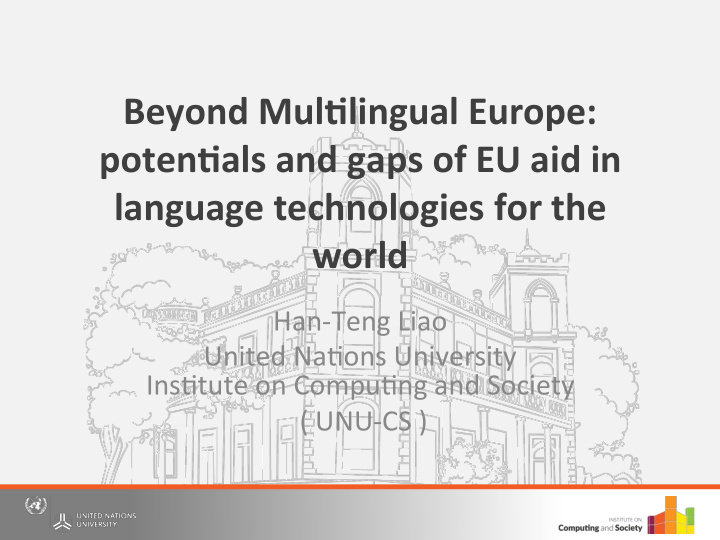



Beyond Mul+lingual Europe: poten+als and gaps of EU aid in language technologies for the world Han-Teng Liao United Na0ons University Ins0tute on Compu0ng and Society ( UNU-CS )
UNU-CS is a research ins0tute at the intersec0ons of ICTs and interna0onal development Source: Olivier Alais hDp:// • ict4dev.org/visi0ng-the-united- na0ons-university-in-macao/
Europe's Digital Single Market must be mul+lingual! (Georg Rehm) Source: hDp://www.meta-net.eu/blog?set_language=de
LT for EU’s int’l coopera+on and development?
The ASEAN Economic Community: towards a Single Market Source: hDp://learning.asean.org/news/asean-na0onal-news/asean-journalists-strive-to-promote-regional-iden0ty-45087.html
China’s AIIB and the ‘One Belt, One Road’ (OBOR)
Some observa+ons ‘The kind of infrastructure financed by the Chinese ini0a0ves is the “hardware” of trade and investment, necessary but not sufficient to deepen integra0on.’ - David Dollar, Brookings ‘”One Belt, One Road”calls for talents of small languages ( 小语种 ).’ - State Council Informa0on office, China
Socie+es under digital and social transforma+on ADB Vice-President • Stephen Groff. 2014. Berlin, Federal Republic of Germany. With over 600 million people, ASEAN‘s poten0al market is larger than the European Union or North America. Next to the People's Republic of China and India, ASEAN has the world's third largest labor force that remains rela0vely young.
Linguis+c dimension of the Belt and Road Ini+a+ve • Current largest online language user communi0es: English, Russian, Arabic, Hindi, Vietnamese, Turkish, Egyp0an Arabic, Bengali, Indonesian, Polish, etc. • Turkish and Polish language user communi0es currently have significant presence on the Internet landscape of the region, a fact that is likely to be contributed to the rela0vely higher Internet penetra0on rates in Turkey and Poland.
META, EU, OBOR Country Countries G roup Austria (AT), Belgium (BE), Cyprus (CY ), Czech Republic (CZ), Germany (DE), M ETA (EU) Denmark (DK), Estonia (EE), Spain (ES), Finland (FI), France (FR), UK (GB), Greece N=28 (GR), Croatia (HR), Hungary (HU), Ireland (IE), Italy (IT), Lithuania (LT), Luxembourg (LU), Latvia (LV), Malta (MT), Netherlands (NL), Poland (PL), Portugal (PT), Sweden (SE), Slovenia (SI), Slovakia (SK), Bulgaria (BG), Romania (RO) M ETA (non EU) Switzerland (CH), Israel (IL), Iceland (IS), Norway (NO), Serbia (RS), Turkey (TR) N=6 OBOR (EU only) Bulgaria (BG), Czech Republic (CZ), Estonia (EE), Croatia (HR), Hungary (HU), N= 11 Lithuania (LT), Latvia (LV), Poland (PL), Romania (RO), Slovenia (SI), Slovakia (SK) (out of 65)
Premise language technologies as a form of international aid that benefits both givers and receivers.
EU DG DEVCO • Delivering EU aid to developing countries. • Many countries need not only guidelines on informa0on and language policies (some of which are provided by UNESCO), but also language technologies and digital resources.
META-NET • the leading regional community with the novice idea that Europe's Digital Single Market must be mul0lingual • META-NET may advocate the no0on that language technologies and services can be delivered as a form of interna0onal aid that benefits both givers and receivers.
Research (Preliminary) • Data source: Ethnologue; DG DEVCO webpages • Theory: a geostrategic theory (geographic pivot of history) modified by sok linguis0c determinism (c.f. geographical determinism) based on globaliza0on of culture and mobility. • Method: Greenberg's Diversity Index (LDI) – Languages in a country – Languages in a country group
Findings: Greenberg’s diversity index No. of No. of G roup LDI G roup LDI Countries Countries LAS 22 0.92733 CPLP 9 0.33437 EU 28 0.92733 EU-Latin-America 18 0.55788 SAARC 8 0.93398 UNASUR 12 0.57088 META 34 0.93786 EU-Caribbean 16 0.62655 ASEAN 10 0.93841 CARICOM 20 0.74027 OBOR 65 0.94112 EU-Central-Asia 5 0.78243 ASEM 50 0.94178 EU-ENP-Russia 17 0.83174 PALOP-TL 5 0.94359 EU-Gulf 3 0.84342 EU-Pacific 10 0.98248 EUROMED 10 0.87183 AU 54 0.98511 OECD 33 0.88457 EU-Saharan-Africa 49 0.99021 APAN 15 0.89962 ACP 80 0.99027 EU-ENP 16 0.91033 EU-ACP 79 0.99073 EU-Asia 18 0.91327 UFM 22 0.91957 TEIN 23 0.92095
EU language technology aid • Language technology (LT) not yet as a form of aid • Easier and ready in La0n America, South America, and Caribbean • Slightly more difficult in EU Neighbourhood region and Russia, and MEMA • META members cover some non EU countries. • ASEAN, OBOR, and ASEM have great poten0als and difficul0es • AU, Saharan Africa, Africa Caribbean Pacific most diverse and requires most efforts.
Sugges+ons • the need for the establishment of similar regional communi0es for and around LT in the rest of the world • the shared aim to evaluate and advance LT support for the languages of the region – par0cularly those regions with emerging single market agenda and Internet users (e.g. ASEAN).
“feeling at home in a wider world (web)” • how do we make users feel at home • the goal to have a “wider and more inclusive” world
Recommend
More recommend